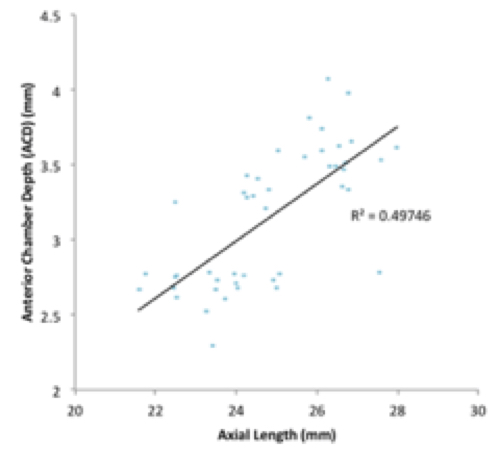Influence of anterior chamber depth on postoperative refractive outcome in Chinese eyes
Abstract
Aim or Purpose: This study aims to evaluate the refractive surprise (RS) after cataract surgery with various intraocular lens (IOL) formulas in eyes with very shallow or deep anterior chamber depth (ACD).
Design: This is a prospective cohort study of patients from a private ophthalmology practice in Sydney.
Methods: Thirty-one patients who had their cataract surgery in 2014 were included. The cohort consists of 20 eyes with ACD < 2.8 mm and 25 eyes with ACD > 3.2 mm. Patients’ demographic variables and their predicted refractive outcomes using the SRK-T, Haigis, Holladay 1, and Holladay 2 IOL formulas were collected. Actual refractive outcomes were obtained from consultations at least one-month postoperatively. RS was calculated from the difference between predicted refraction outcome of IOL formulas and the actual postoperative refraction achieved.
Results: The linear correlations between ACD and RS were not significant (p > 0.05). In the group with ACD < 2.8 mm, the mean refractive surprise using SRK-T, Haigis, Holladay 1, and Holladay 2 formulas were -0.191 ± 0.541, -0.189 ± 0.444, -0.201 ± 0.449, and -0.154 ± 0.489 D, respectively. In the group with ACD > 3.2 mm, the mean refractive surprise using the IOL formulas were -1.364 ± 0.541, -1.420 ± 0.541, 0.027 ± 0.394, and -0.045 ± 0.343 D, respectively.
Conclusion: The positive linear correlation between ACD and RS was weak. In eyes with ACD < 2.8 mm, the least RS was found with the Holladay 2 formula, while in eyes with ACD > 3.2 mm, this was found with Holladay 1.
References
2. Yanoff M, Duker JS. Ophthalmology. 4th ed. China: Saunders; 2014.
3. Hoffman RS, Vasavada AR, Allen QB, et al. Cataract surgery in the small eye. J Cataract Refract Surg. 2015;41(11):2565-2575. doi:10.1016/j.jcrs.2015.10.008.
4. Muthappan V, Paskowitz D, Kazimierczak A, Jun AS, Ladas J, Kuo IC. Measurement and use of postoperative anterior chamber depth of fellow eye in refractive outcomes. J Cataract Refract Surg. 2015;41(4):778-784. doi:10.1016/j.jcrs.2014.08.034.
5. Abulafia A, Barrett GD, Rotenberg M et al. Intraocular lens power calculation for eyes with an axial length greater than 26.0 mm: comparison of formulas and methods. J Cataract Refract Surg. 2015;41(3):548-556. doi:10.1016/j.jcrs.2014.06.033.
6. Stephenson M. Refractive surprises after cataract surgery: The best treatment depends on the amount of residual error: Newtown Square: Review of Ophthalmology; 2016. http://www.reviewofophthalmology.com/content/i/2713/c/45992/. Accessed Jan 2016.
7. Saal WV. Statistical significance of correlations. Oneonta: The State University of New York; 2005. http://www.oneonta.edu/faculty/vomsaaw/w/psy220/files/SignifOfCorrelations.htm. Accessed Feb 2016.
8. Norrby S. Sources of error in intraocular lens power calculation. J Cataract Refract Surg. 2008;34(3):368-376. doi:10.1016/j.jcrs.2007.10.031.
9. Carifi G, Aiello F, Zygoura V, Kopsachilis N, Maurino V. Accuracy of the refractive prediction determined by multiple currently available intraocular lens power calculation formulas in small eyes. 2015;159(3):577-583. doi:10.1016/j.ajo.2014.11.036.
10. Miraftab M, Hashemi H, Fotouhi A, Khabazkhoob M, Rezvan F, Asgari S. Effect of anterior chamber depth on the choice of intraocular lens calculation formula in patients with normal axial length. Middle East Afr J Ophthalmol. 2014;21(4):307-311. doi:10.4103/0974-9233.142266.
11. Olsen T, Olesen H, Thim K, Corydon L. Prediction of pseudophakic anterior chamber depth with the newer IOL calculation formulas. J Cataract Refract Surg. 1992 May;18(3):280-285.
12. Atchison DA, Markwell EL. Aberrations of emmetropic subjects at different ages. Vision Res. 2008;48(21):2224-2231. doi:10.1016/j.visres.2008.06.023
13. Steinert RF. Cataract surgery. 3rd ed. California: Saunders; 2010.
14. East Valley Ophthalmology. Zeiss IOLMaster Online Users Instruction Manual V.4 – Anterior Chamber Depth. Jena: Carl Zeiss Meditect AG, 2005. http://www.doctor-hill.com/iol-master/acd.htm. Accessed March 2016.

Copyright (c) 2018 Asian Journal of Ophthalmology

This work is licensed under a Creative Commons Attribution 4.0 International License.
Authors who publish with this journal agree to the following terms:
- Authors retain copyright and grant the journal right of first publication, with the work twelve (12) months after publication simultaneously licensed under a Creative Commons Attribution License that allows others to share the work with an acknowledgement of the work's authorship and initial publication in this journal.
- Authors are able to enter into separate, additional contractual arrangements for the non-exclusive distribution of the journal's published version of the work (e.g., post it to an institutional repository or publish it in a book), with an acknowledgement of its initial publication in this journal.
- Authors are permitted and encouraged to post their work online (e.g., in institutional repositories or on their website) prior to and during the submission process, as it can lead to productive exchanges, as well as earlier and greater citation of published work (See The Effect of Open Access).


